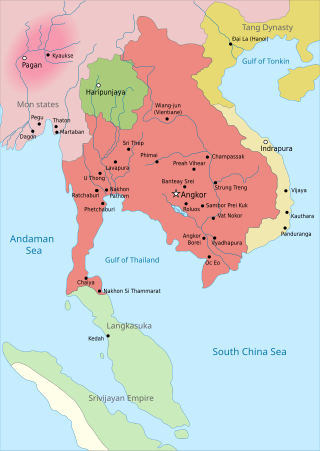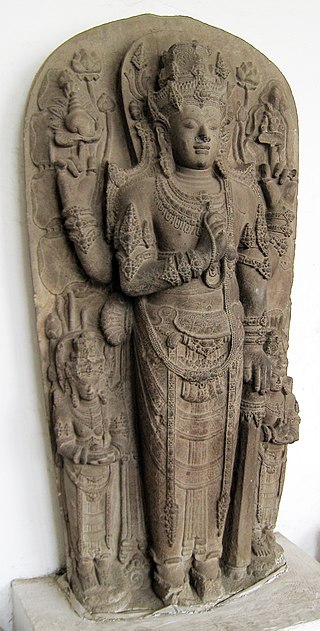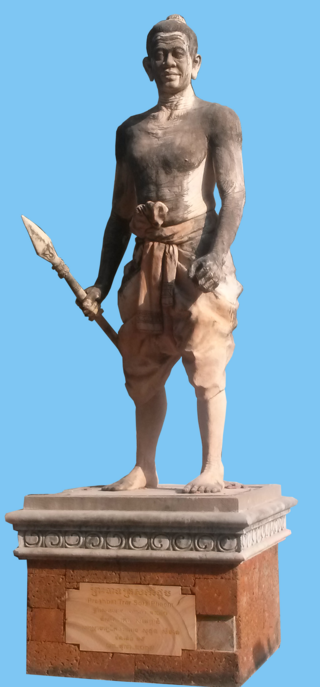The history of Cambodia, a country in mainland Southeast Asia, can be traced back to Indian civilization. Detailed records of a political structure on the territory of what is now Cambodia first appear in Chinese annals in reference to Funan, a polity that encompassed the southernmost part of the Indochinese peninsula during the 1st to 6th centuries. Centered at the lower Mekong, Funan is noted as the oldest regional Hindu culture, which suggests prolonged socio-economic interaction with maritime trading partners of the Indosphere in the west. By the 6th century a civilization, called Chenla or Zhenla in Chinese annals, firmly replaced Funan, as it controlled larger, more undulating areas of Indochina and maintained more than a singular centre of power.

The Khmer Empire was a Hindu-Buddhist empire in Southeast Asia, centered around hydraulic cities in what is now northern Cambodia. Known as Kambuja by its inhabitants, it grew out of the former civilisation of Chenla and lasted from 802 to 1431. Historians call this period of Cambodian history the Angkor period, after the empire's most well-known capital, Angkor. The Khmer Empire ruled or vassalised most of mainland Southeast Asia and stretched as far north as southern China. At its peak, the Empire was larger than the Byzantine Empire, which existed around the same time.
The early history of Cambodia follows the prehistoric and protohistoric development of Cambodia as a country in mainland Southeast Asia. Thanks to archaeological work carried out since 2009 this can now be traced back to the Neolithic period. As excavation sites have become more numerous and modern dating methods are applied, settlement traces of all stages of human civil development from neolithic hunter-gatherer groups to organized preliterate societies are documented in the region.

The post-Angkor period of Cambodia, also called the Middle Period, refers to the historical era from the early 15th century to 1863, the beginning of the French protectorate of Cambodia. As reliable sources are very rare, a defensible and conclusive explanation that relates to concrete events that manifest the decline of the Khmer Empire, recognised unanimously by the scientific community, has so far not been produced. However, most modern historians have approached a consensus in which several distinct and gradual changes of religious, dynastic, administrative and military nature, environmental problems and ecological imbalance coincided with shifts of power in Indochina and must all be taken into account to make an interpretation. In recent years scholars' focus has shifted increasingly towards human–environment interactions and the ecological consequences, including natural disasters, such as flooding and droughts.

Chenla or Zhenla is the Chinese designation for the successor polity of the kingdom of Funan preceding the Khmer Empire that existed from around the late sixth to the early ninth century in Indochina. The name was still used in the 13th century by the Chinese envoy Zhou Daguan, author of The Customs of Cambodia. It appears on the Mao Kun map. However, modern historiography applies the name exclusively to the period from the late 6th to the early ninth century. This period of Cambodian history is known by historians as the Pre-Angkor period. It is doubted whether Chenla ever existed as a unitary kingdom, or if this is a misconception by Chinese chroniclers. Most modern historians assert that "Chenla" was in fact just a series of loose and temporary confederations of principalities in the pre-Angkor period.

George Cœdès was a French scholar of southeast Asian archaeology and history.

Cambodian literature, also Khmer literature, has a very ancient origin. Like most Southeast Asian national literatures its traditional corpus has two distinct aspects or levels:

Devaraja was a religious order of the "god-king," or deified monarch in medieval Southeast Asia. The devarāja order grew out of both Hinduism and separate local traditions depending on the area. It taught that the king was a divine universal ruler, a manifestation of Bhagavan. The concept viewed the monarch to possess transcendental quality, the king as the living god on earth. The concept is closely related to the Indian concept of Chakravarti. In politics, it is viewed as the divine justification of a king's rule. The concept was institutionalized and gained its elaborate manifestations in ancient Java and Cambodia, where monuments such as Prambanan and Angkor Wat were erected to celebrate the king's divine rule on earth.
Khin Sok was a Cambodian historian, linguist, literature and arts scholar. He acquired a doctorate of history in Paris, published scientific works, taught as a professor in the Royal University of Phnom Penh and was a member of the Royal Academy of Cambodia. His publications during the second half of the 20th century profoundly contributed to the scientific interpretation of historical sources, literature and the systemic development of the modern Khmer language. As a participant of the Khmerization movement he encouraged the promotion of a culturally independent Cambodia on the basis of enlightened and scholarly education in an international context.
Thommo Reachea II (1602–1631), also known as Ponhea To or Cau Bana Tu, was the Cambodian king who reigned from 1628 to 1631.
Kaev Hua I, also known as Ponhea Nhom, was the Cambodian king ruled from 1600 to 1603.

Wat Vihear Suor is a Theravada Buddhist temple located in Kandal Province, Cambodia. It was built on an older pre-Buddhist cult site belonging to the Angkor era.

Somdach Veang Thiounn was a Cambodian state official of the Khmer nobility during the French protectorate of Cambodia who had a lasting influence on Khmer historiography through the Cambodian Royal Chronicles. While he has been described as the shogun of the French protectorate and a "comprador feudalist", others have praised his long service to the Kingdom of Cambodia, as "the epitome of the colonial subject who quickly saw how to turn the new regime to an advantage":

The Grande Inscription d’Angkor, referenced as K. 301 or Inscription Modern Angkor Wat (IMA) #38, is the longest Khmer inscription at Angkor Wat. Dated to 1701, it is located on the east wall between the bas-relief galleries and facing the Chey Non stupa in the courtyard outside.

Trasak Paem is commonly considered as a ruler from legend of the Khmer Empire who presumably died around 1340.
Bernard Col de Monteiro was a Khmer Catholic of Portuguese descent who served the Cambodian monarchy during the second half of the 19th century, and was "one of the major mandarins of King Norodom" and a "member of the new-old national élite à la française" at the beginning the French protectorate of Cambodia.

The Austroasiatic crossbow which is also known as the Hmong crossbow, the Jarai crossbow, or the Angkorian crossbow is a crossbow used for war and for hunting in Southeastern Asia. It has become a symbol of pride and identity for ethnic groups from Myanmar (Burma) to the confines of Indochina.

Samdech Preah Moha Sangkha Reach Nil Teang or Nil Tieng as it was written during the French protectorate of Cambodia, was the first Supreme Patriarch of Cambodia in the Mahanikaya. He held that position during the reign of three consecutive kings: King Preah Ang Duong, King Norodom, King Sisowath.
The Khmer nobility is a social class comprising titled officials in the service of the monarchy. They form part of a hierarchical social system which developed from the time of the Angkorian Empire. While all titles were abolished by Pol Pot under the Democratic Kampuchea, they were restored and have multiplied since the restoration of monarchy in 1990 by late King Father Norodom Sihanouk.
The fall of Longkvek, also known as the sack of Longvek or siege of Longvek, was the final act of the Siamese–Cambodian War which lasted from 1591 to 1594 and after which the Khmer capital Longvek was ransacked and looted. After the Khmer refused to recognize Ayutthaya authority, the Ayutthaya Kingdom besieged Longvek and sacked the capital city. After the fall of Angkor, the conquest of Longvek was another blow to Khmer sovoreignty, which was not restored for many more centuries, initiating the period known as the "dark age" of Cambodia.













